Research Project: Lending Services Impact on KWFT Performance
VerifiedAdded on 2022/03/02
|38
|7245
|50
Project
AI Summary
This research project examines the effects of lending services on the performance of microfinance institutions (MFIs) in Kenya, using the Kenya Women Finance Trust (KWFT) Bungoma Branch as a case study. The study investigates the influence of loaning periods, repayment terms, and security policies on the financial performance of KWFT. Employing a descriptive research design and targeting 10 employees, the study utilizes questionnaires to collect data, which is then analyzed using descriptive statistics and presented in APA tables. The findings reveal a direct correlation between loaning periods, repayment terms, security policies and the performance of KWFT. The project also includes a review of relevant literature, including theoretical frameworks such as the theory of capital structure, and provides recommendations based on the research findings.
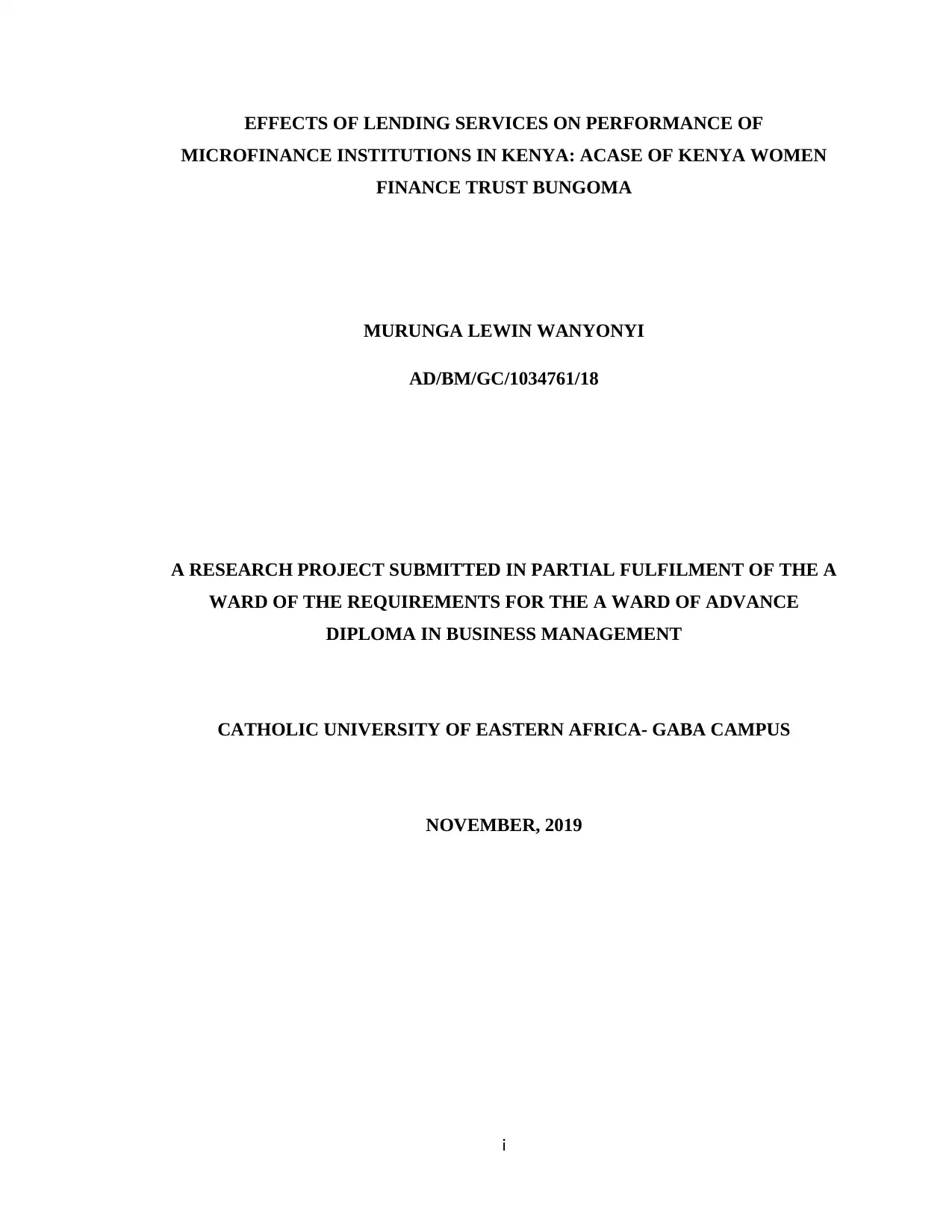
EFFECTS OF LENDING SERVICES ON PERFORMANCE OF
MICROFINANCE INSTITUTIONS IN KENYA: ACASE OF KENYA WOMEN
FINANCE TRUST BUNGOMA
MURUNGA LEWIN WANYONYI
AD/BM/GC/1034761/18
A RESEARCH PROJECT SUBMITTED IN PARTIAL FULFILMENT OF THE A
WARD OF THE REQUIREMENTS FOR THE A WARD OF ADVANCE
DIPLOMA IN BUSINESS MANAGEMENT
CATHOLIC UNIVERSITY OF EASTERN AFRICA- GABA CAMPUS
NOVEMBER, 2019
i
MICROFINANCE INSTITUTIONS IN KENYA: ACASE OF KENYA WOMEN
FINANCE TRUST BUNGOMA
MURUNGA LEWIN WANYONYI
AD/BM/GC/1034761/18
A RESEARCH PROJECT SUBMITTED IN PARTIAL FULFILMENT OF THE A
WARD OF THE REQUIREMENTS FOR THE A WARD OF ADVANCE
DIPLOMA IN BUSINESS MANAGEMENT
CATHOLIC UNIVERSITY OF EASTERN AFRICA- GABA CAMPUS
NOVEMBER, 2019
i
Paraphrase This Document
Need a fresh take? Get an instant paraphrase of this document with our AI Paraphraser
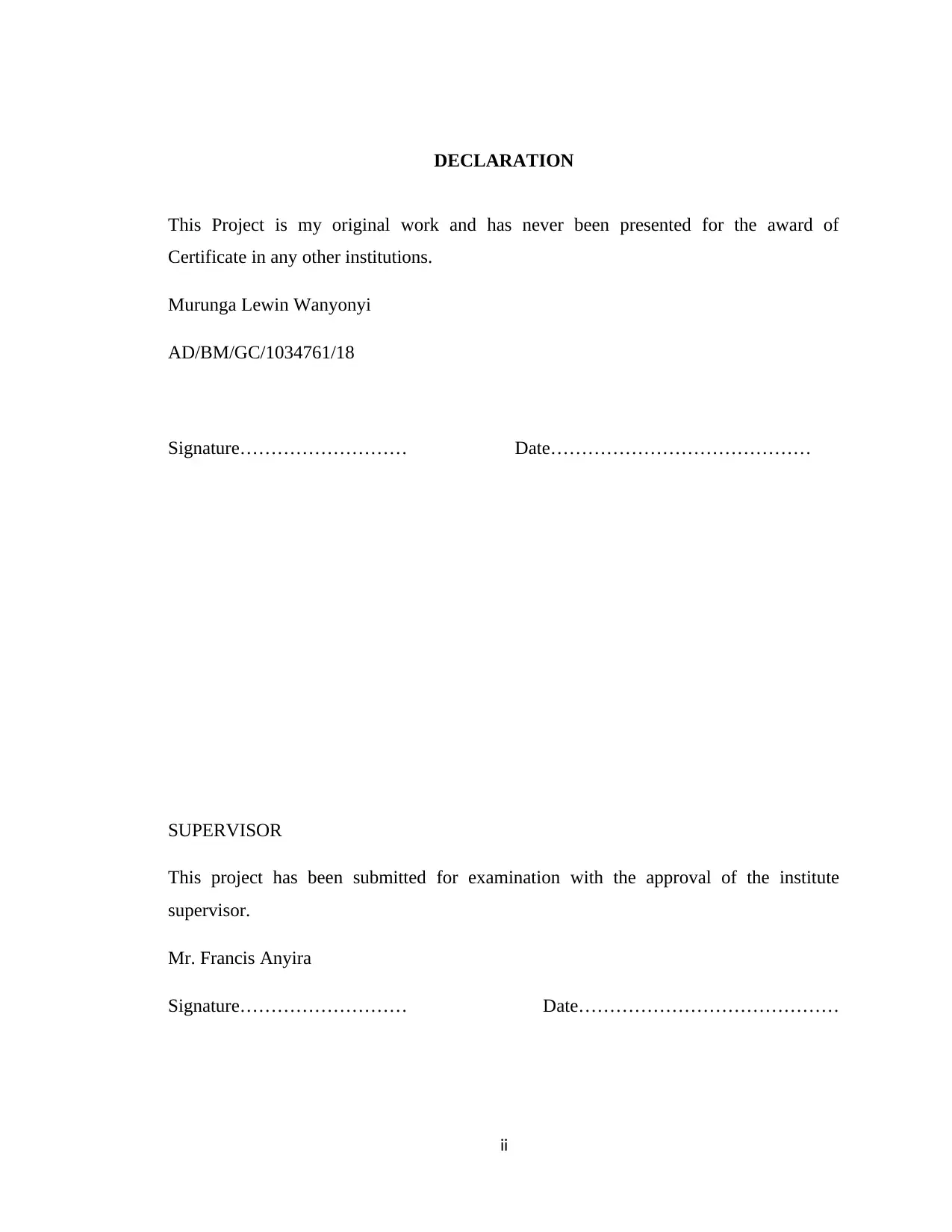
DECLARATION
This Project is my original work and has never been presented for the award of
Certificate in any other institutions.
Murunga Lewin Wanyonyi
AD/BM/GC/1034761/18
Signature……………………… Date……………………………………
SUPERVISOR
This project has been submitted for examination with the approval of the institute
supervisor.
Mr. Francis Anyira
Signature……………………… Date……………………………………
ii
This Project is my original work and has never been presented for the award of
Certificate in any other institutions.
Murunga Lewin Wanyonyi
AD/BM/GC/1034761/18
Signature……………………… Date……………………………………
SUPERVISOR
This project has been submitted for examination with the approval of the institute
supervisor.
Mr. Francis Anyira
Signature……………………… Date……………………………………
ii
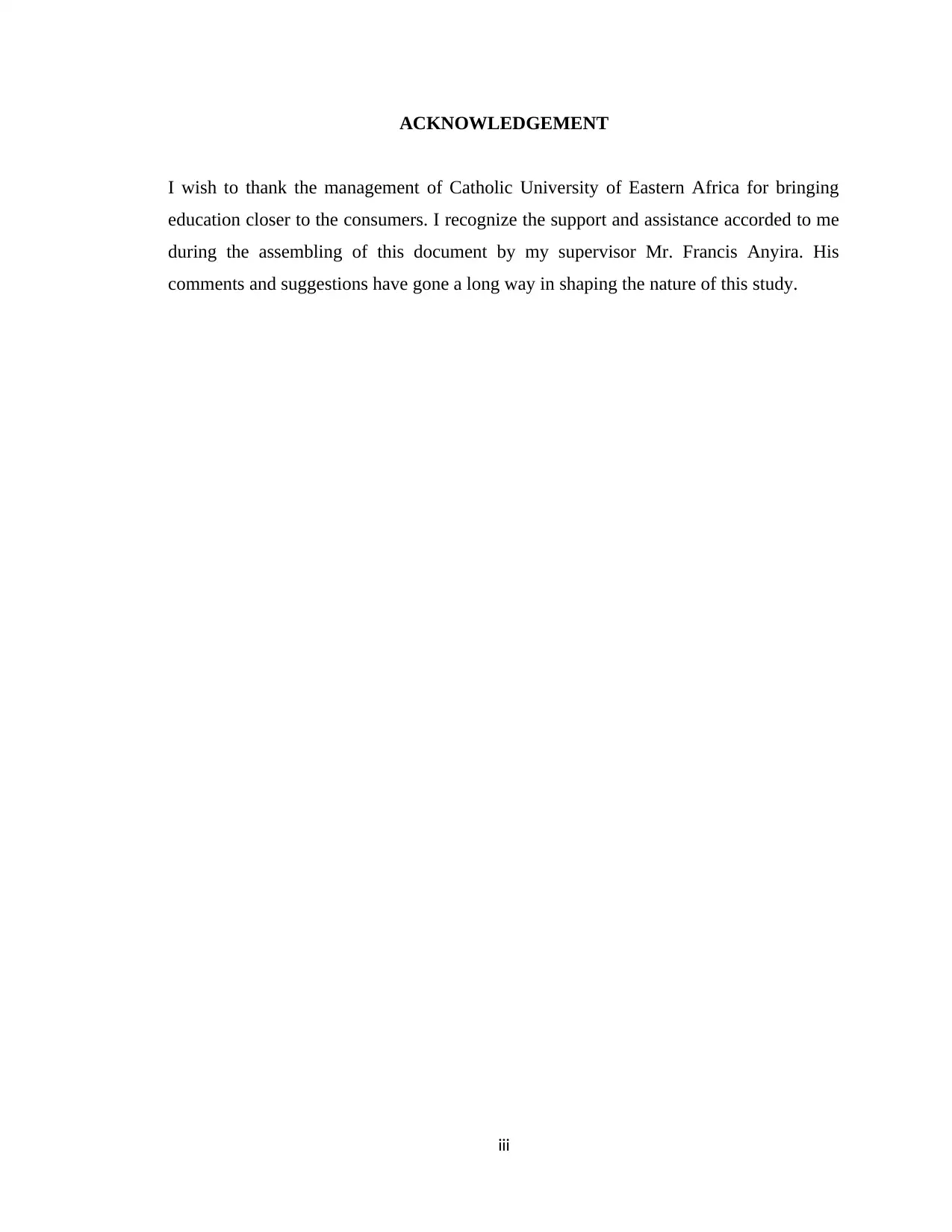
ACKNOWLEDGEMENT
I wish to thank the management of Catholic University of Eastern Africa for bringing
education closer to the consumers. I recognize the support and assistance accorded to me
during the assembling of this document by my supervisor Mr. Francis Anyira. His
comments and suggestions have gone a long way in shaping the nature of this study.
iii
I wish to thank the management of Catholic University of Eastern Africa for bringing
education closer to the consumers. I recognize the support and assistance accorded to me
during the assembling of this document by my supervisor Mr. Francis Anyira. His
comments and suggestions have gone a long way in shaping the nature of this study.
iii
⊘ This is a preview!⊘
Do you want full access?
Subscribe today to unlock all pages.

Trusted by 1+ million students worldwide
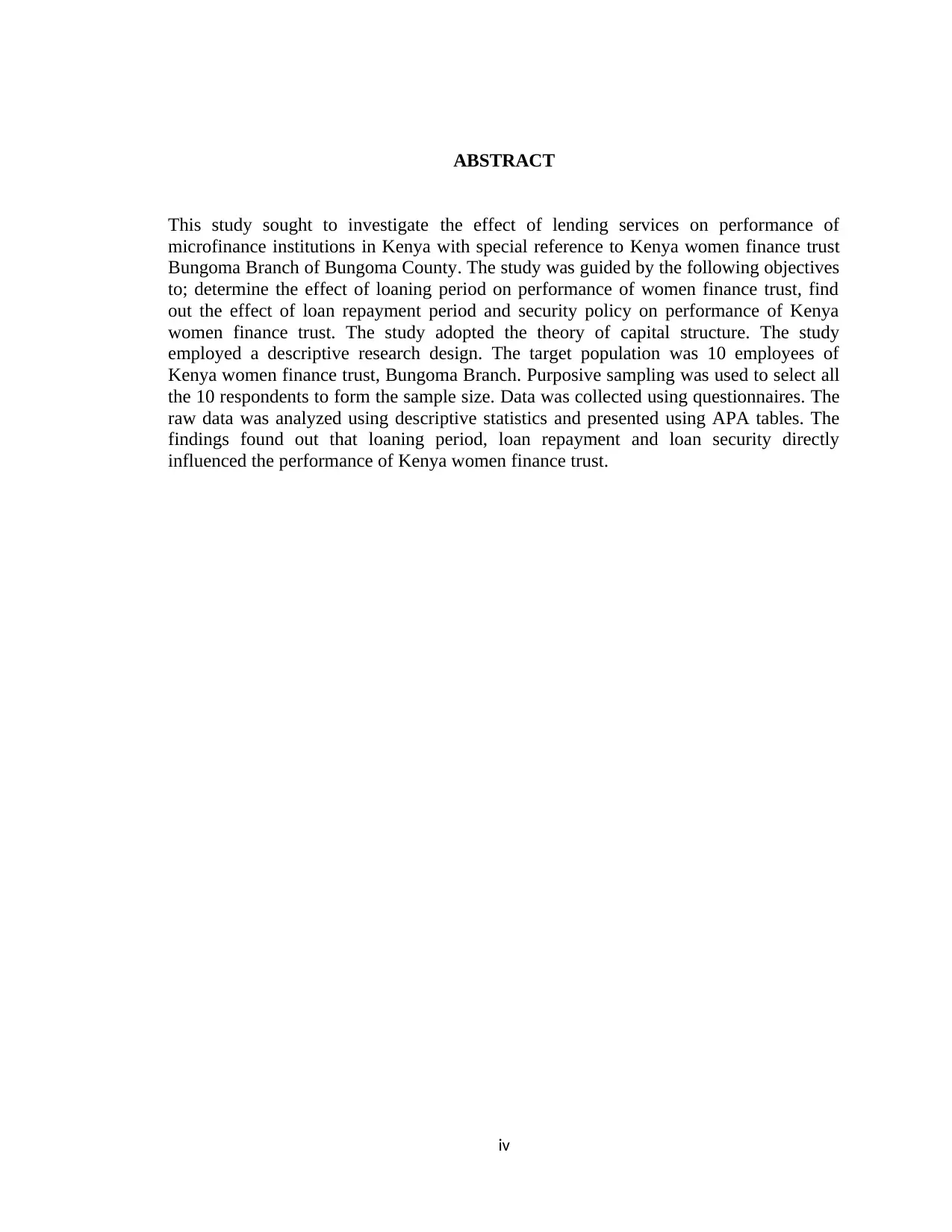
ABSTRACT
This study sought to investigate the effect of lending services on performance of
microfinance institutions in Kenya with special reference to Kenya women finance trust
Bungoma Branch of Bungoma County. The study was guided by the following objectives
to; determine the effect of loaning period on performance of women finance trust, find
out the effect of loan repayment period and security policy on performance of Kenya
women finance trust. The study adopted the theory of capital structure. The study
employed a descriptive research design. The target population was 10 employees of
Kenya women finance trust, Bungoma Branch. Purposive sampling was used to select all
the 10 respondents to form the sample size. Data was collected using questionnaires. The
raw data was analyzed using descriptive statistics and presented using APA tables. The
findings found out that loaning period, loan repayment and loan security directly
influenced the performance of Kenya women finance trust.
iv
This study sought to investigate the effect of lending services on performance of
microfinance institutions in Kenya with special reference to Kenya women finance trust
Bungoma Branch of Bungoma County. The study was guided by the following objectives
to; determine the effect of loaning period on performance of women finance trust, find
out the effect of loan repayment period and security policy on performance of Kenya
women finance trust. The study adopted the theory of capital structure. The study
employed a descriptive research design. The target population was 10 employees of
Kenya women finance trust, Bungoma Branch. Purposive sampling was used to select all
the 10 respondents to form the sample size. Data was collected using questionnaires. The
raw data was analyzed using descriptive statistics and presented using APA tables. The
findings found out that loaning period, loan repayment and loan security directly
influenced the performance of Kenya women finance trust.
iv
Paraphrase This Document
Need a fresh take? Get an instant paraphrase of this document with our AI Paraphraser
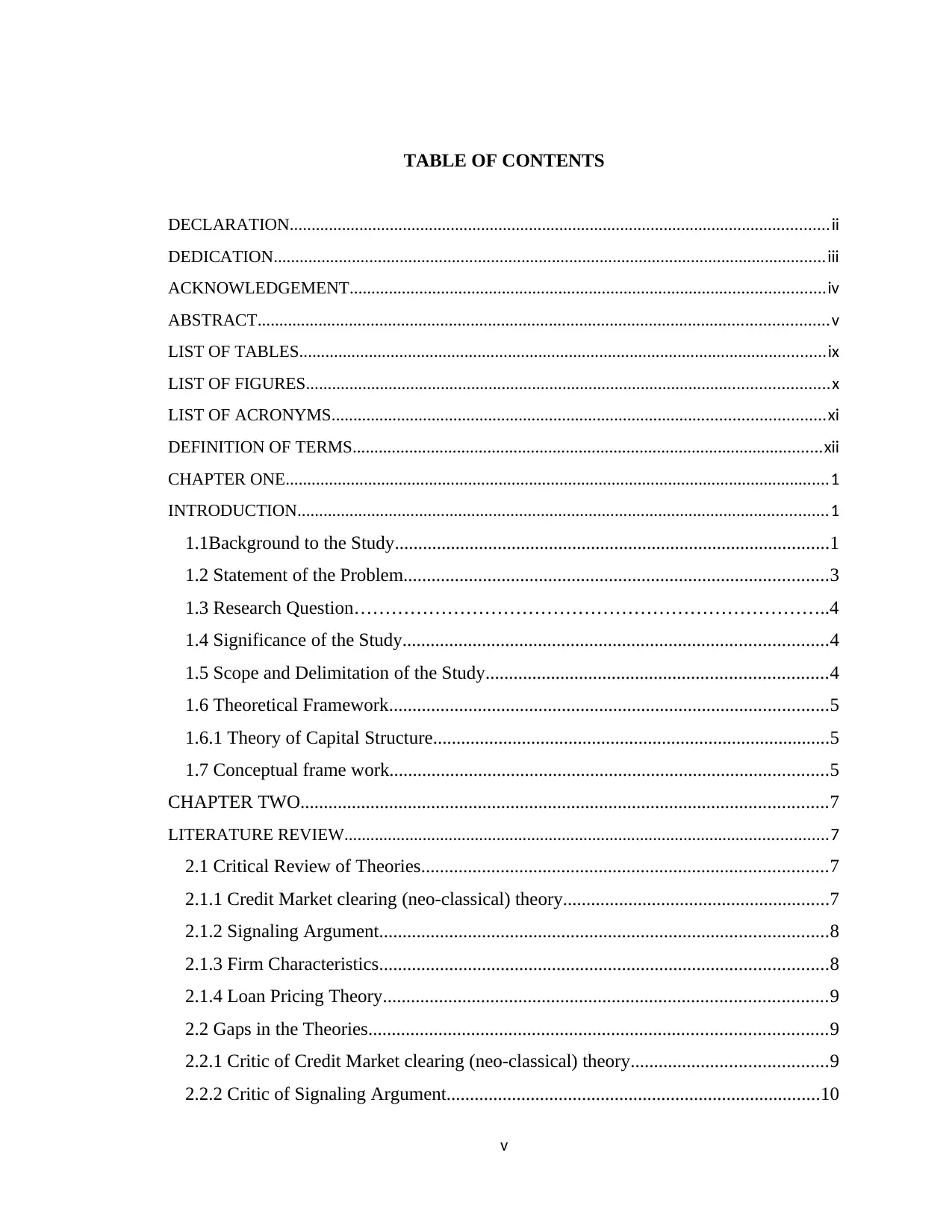
TABLE OF CONTENTS
DECLARATION............................................................................................................................ii
DEDICATION...............................................................................................................................iii
ACKNOWLEDGEMENT.............................................................................................................iv
ABSTRACT...................................................................................................................................v
LIST OF TABLES.........................................................................................................................ix
LIST OF FIGURES........................................................................................................................x
LIST OF ACRONYMS.................................................................................................................xi
DEFINITION OF TERMS............................................................................................................xii
CHAPTER ONE.............................................................................................................................1
INTRODUCTION..........................................................................................................................1
1.1Background to the Study.............................................................................................1
1.2 Statement of the Problem...........................................................................................3
1.3 Research Question…………………………………………………………………..4
1.4 Significance of the Study...........................................................................................4
1.5 Scope and Delimitation of the Study.........................................................................4
1.6 Theoretical Framework..............................................................................................5
1.6.1 Theory of Capital Structure.....................................................................................5
1.7 Conceptual frame work..............................................................................................5
CHAPTER TWO.................................................................................................................7
LITERATURE REVIEW...............................................................................................................7
2.1 Critical Review of Theories.......................................................................................7
2.1.1 Credit Market clearing (neo-classical) theory.........................................................7
2.1.2 Signaling Argument................................................................................................8
2.1.3 Firm Characteristics................................................................................................8
2.1.4 Loan Pricing Theory...............................................................................................9
2.2 Gaps in the Theories..................................................................................................9
2.2.1 Critic of Credit Market clearing (neo-classical) theory..........................................9
2.2.2 Critic of Signaling Argument................................................................................10
v
DECLARATION............................................................................................................................ii
DEDICATION...............................................................................................................................iii
ACKNOWLEDGEMENT.............................................................................................................iv
ABSTRACT...................................................................................................................................v
LIST OF TABLES.........................................................................................................................ix
LIST OF FIGURES........................................................................................................................x
LIST OF ACRONYMS.................................................................................................................xi
DEFINITION OF TERMS............................................................................................................xii
CHAPTER ONE.............................................................................................................................1
INTRODUCTION..........................................................................................................................1
1.1Background to the Study.............................................................................................1
1.2 Statement of the Problem...........................................................................................3
1.3 Research Question…………………………………………………………………..4
1.4 Significance of the Study...........................................................................................4
1.5 Scope and Delimitation of the Study.........................................................................4
1.6 Theoretical Framework..............................................................................................5
1.6.1 Theory of Capital Structure.....................................................................................5
1.7 Conceptual frame work..............................................................................................5
CHAPTER TWO.................................................................................................................7
LITERATURE REVIEW...............................................................................................................7
2.1 Critical Review of Theories.......................................................................................7
2.1.1 Credit Market clearing (neo-classical) theory.........................................................7
2.1.2 Signaling Argument................................................................................................8
2.1.3 Firm Characteristics................................................................................................8
2.1.4 Loan Pricing Theory...............................................................................................9
2.2 Gaps in the Theories..................................................................................................9
2.2.1 Critic of Credit Market clearing (neo-classical) theory..........................................9
2.2.2 Critic of Signaling Argument................................................................................10
v
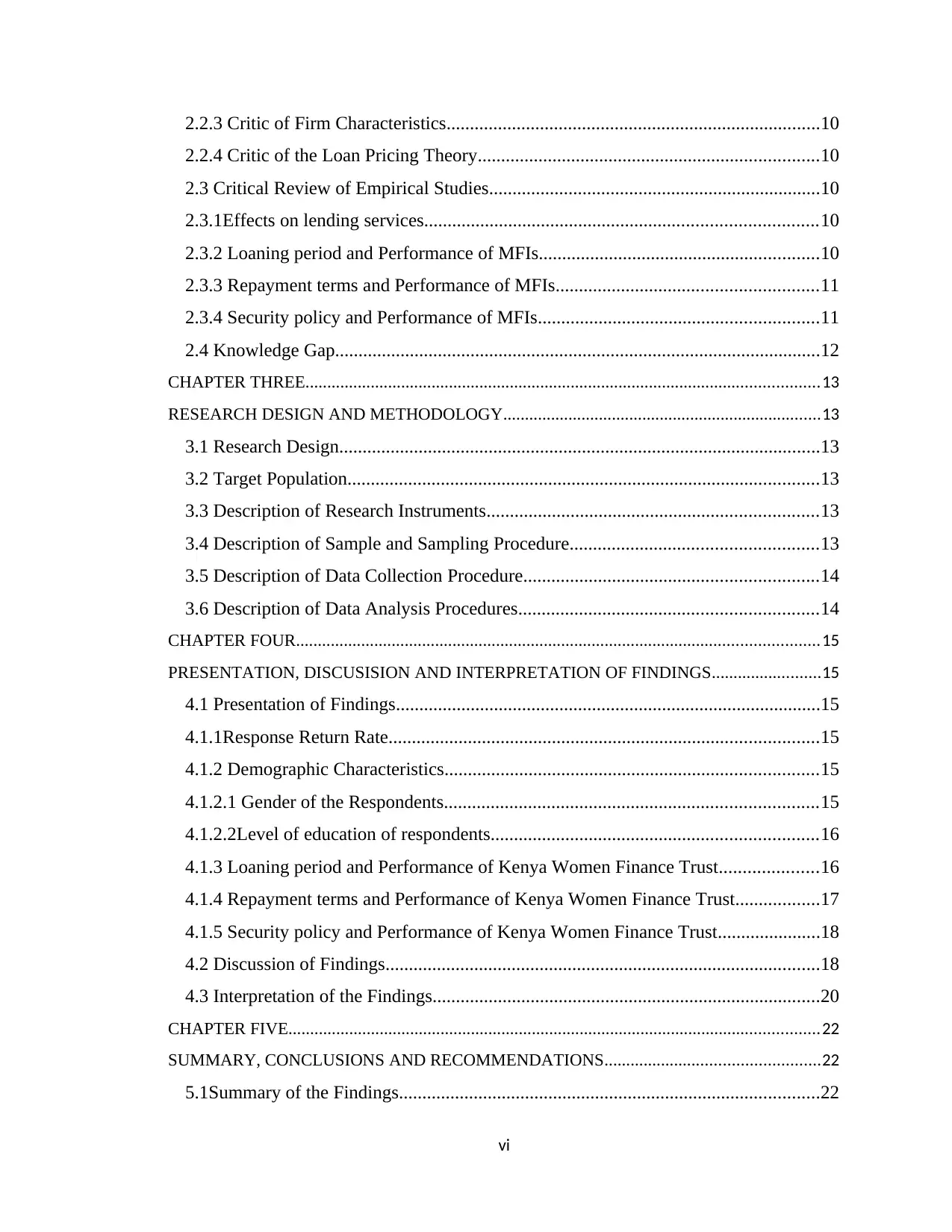
2.2.3 Critic of Firm Characteristics................................................................................10
2.2.4 Critic of the Loan Pricing Theory.........................................................................10
2.3 Critical Review of Empirical Studies.......................................................................10
2.3.1Effects on lending services....................................................................................10
2.3.2 Loaning period and Performance of MFIs............................................................10
2.3.3 Repayment terms and Performance of MFIs........................................................11
2.3.4 Security policy and Performance of MFIs............................................................11
2.4 Knowledge Gap........................................................................................................12
CHAPTER THREE......................................................................................................................13
RESEARCH DESIGN AND METHODOLOGY.........................................................................13
3.1 Research Design.......................................................................................................13
3.2 Target Population.....................................................................................................13
3.3 Description of Research Instruments.......................................................................13
3.4 Description of Sample and Sampling Procedure.....................................................13
3.5 Description of Data Collection Procedure...............................................................14
3.6 Description of Data Analysis Procedures................................................................14
CHAPTER FOUR........................................................................................................................15
PRESENTATION, DISCUSISION AND INTERPRETATION OF FINDINGS.........................15
4.1 Presentation of Findings...........................................................................................15
4.1.1Response Return Rate............................................................................................15
4.1.2 Demographic Characteristics................................................................................15
4.1.2.1 Gender of the Respondents................................................................................15
4.1.2.2Level of education of respondents......................................................................16
4.1.3 Loaning period and Performance of Kenya Women Finance Trust.....................16
4.1.4 Repayment terms and Performance of Kenya Women Finance Trust..................17
4.1.5 Security policy and Performance of Kenya Women Finance Trust......................18
4.2 Discussion of Findings.............................................................................................18
4.3 Interpretation of the Findings...................................................................................20
CHAPTER FIVE..........................................................................................................................22
SUMMARY, CONCLUSIONS AND RECOMMENDATIONS.................................................22
5.1Summary of the Findings..........................................................................................22
vi
2.2.4 Critic of the Loan Pricing Theory.........................................................................10
2.3 Critical Review of Empirical Studies.......................................................................10
2.3.1Effects on lending services....................................................................................10
2.3.2 Loaning period and Performance of MFIs............................................................10
2.3.3 Repayment terms and Performance of MFIs........................................................11
2.3.4 Security policy and Performance of MFIs............................................................11
2.4 Knowledge Gap........................................................................................................12
CHAPTER THREE......................................................................................................................13
RESEARCH DESIGN AND METHODOLOGY.........................................................................13
3.1 Research Design.......................................................................................................13
3.2 Target Population.....................................................................................................13
3.3 Description of Research Instruments.......................................................................13
3.4 Description of Sample and Sampling Procedure.....................................................13
3.5 Description of Data Collection Procedure...............................................................14
3.6 Description of Data Analysis Procedures................................................................14
CHAPTER FOUR........................................................................................................................15
PRESENTATION, DISCUSISION AND INTERPRETATION OF FINDINGS.........................15
4.1 Presentation of Findings...........................................................................................15
4.1.1Response Return Rate............................................................................................15
4.1.2 Demographic Characteristics................................................................................15
4.1.2.1 Gender of the Respondents................................................................................15
4.1.2.2Level of education of respondents......................................................................16
4.1.3 Loaning period and Performance of Kenya Women Finance Trust.....................16
4.1.4 Repayment terms and Performance of Kenya Women Finance Trust..................17
4.1.5 Security policy and Performance of Kenya Women Finance Trust......................18
4.2 Discussion of Findings.............................................................................................18
4.3 Interpretation of the Findings...................................................................................20
CHAPTER FIVE..........................................................................................................................22
SUMMARY, CONCLUSIONS AND RECOMMENDATIONS.................................................22
5.1Summary of the Findings..........................................................................................22
vi
⊘ This is a preview!⊘
Do you want full access?
Subscribe today to unlock all pages.

Trusted by 1+ million students worldwide

5.3 Recommendations....................................................................................................23
REFERENCES.............................................................................................................................25
APPENDIX ONE: QUESTIONNAIRE FOR RESPONDENTS..................................................27
vii
REFERENCES.............................................................................................................................25
APPENDIX ONE: QUESTIONNAIRE FOR RESPONDENTS..................................................27
vii
Paraphrase This Document
Need a fresh take? Get an instant paraphrase of this document with our AI Paraphraser
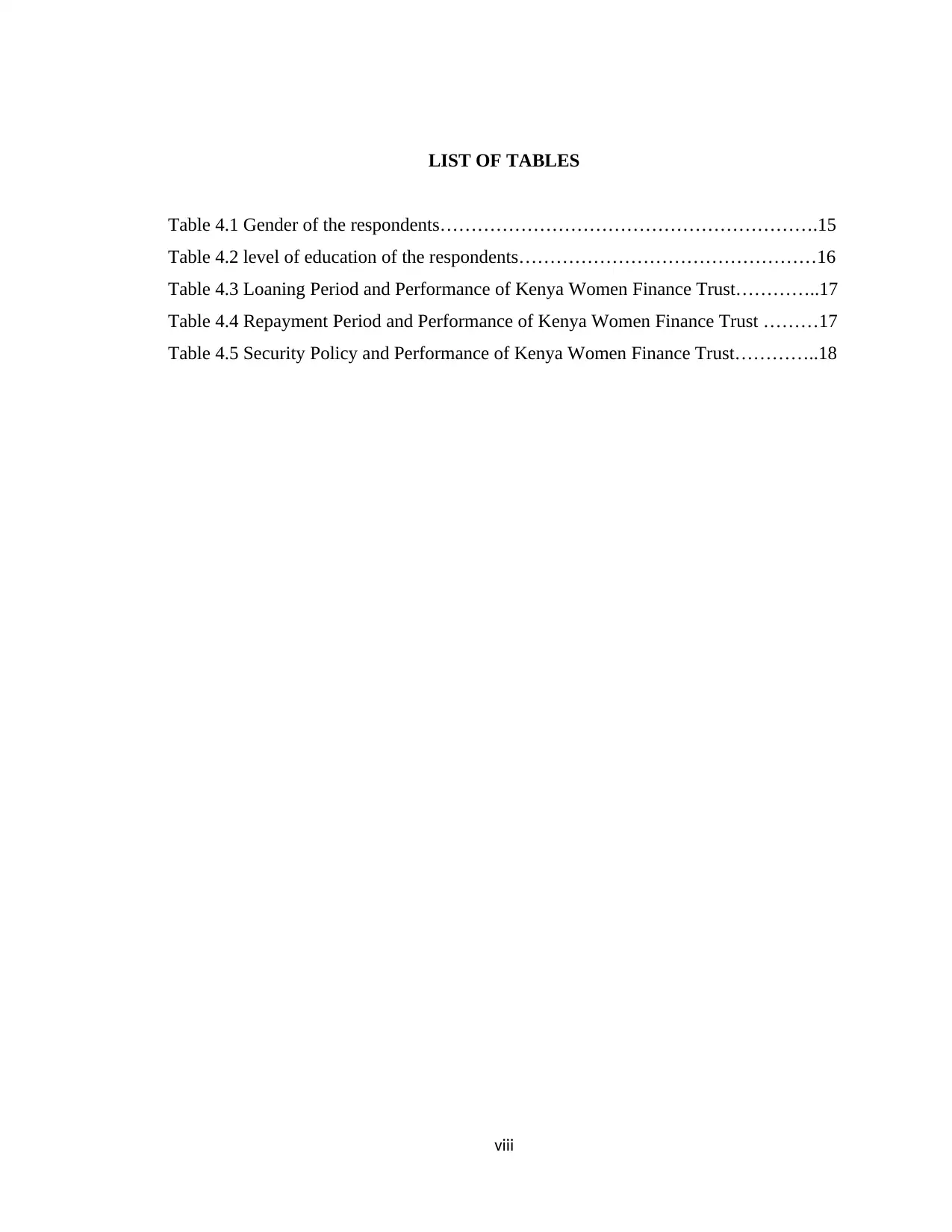
LIST OF TABLES
Table 4.1 Gender of the respondents…………………………………………………….15
Table 4.2 level of education of the respondents…………………………………………16
Table 4.3 Loaning Period and Performance of Kenya Women Finance Trust…………..17
Table 4.4 Repayment Period and Performance of Kenya Women Finance Trust ………17
Table 4.5 Security Policy and Performance of Kenya Women Finance Trust…………..18
viii
Table 4.1 Gender of the respondents…………………………………………………….15
Table 4.2 level of education of the respondents…………………………………………16
Table 4.3 Loaning Period and Performance of Kenya Women Finance Trust…………..17
Table 4.4 Repayment Period and Performance of Kenya Women Finance Trust ………17
Table 4.5 Security Policy and Performance of Kenya Women Finance Trust…………..18
viii

LIST OF FIGURES
Figure 1.1: Conceptual frame work .............................................................................6
ix
Figure 1.1: Conceptual frame work .............................................................................6
ix
⊘ This is a preview!⊘
Do you want full access?
Subscribe today to unlock all pages.

Trusted by 1+ million students worldwide
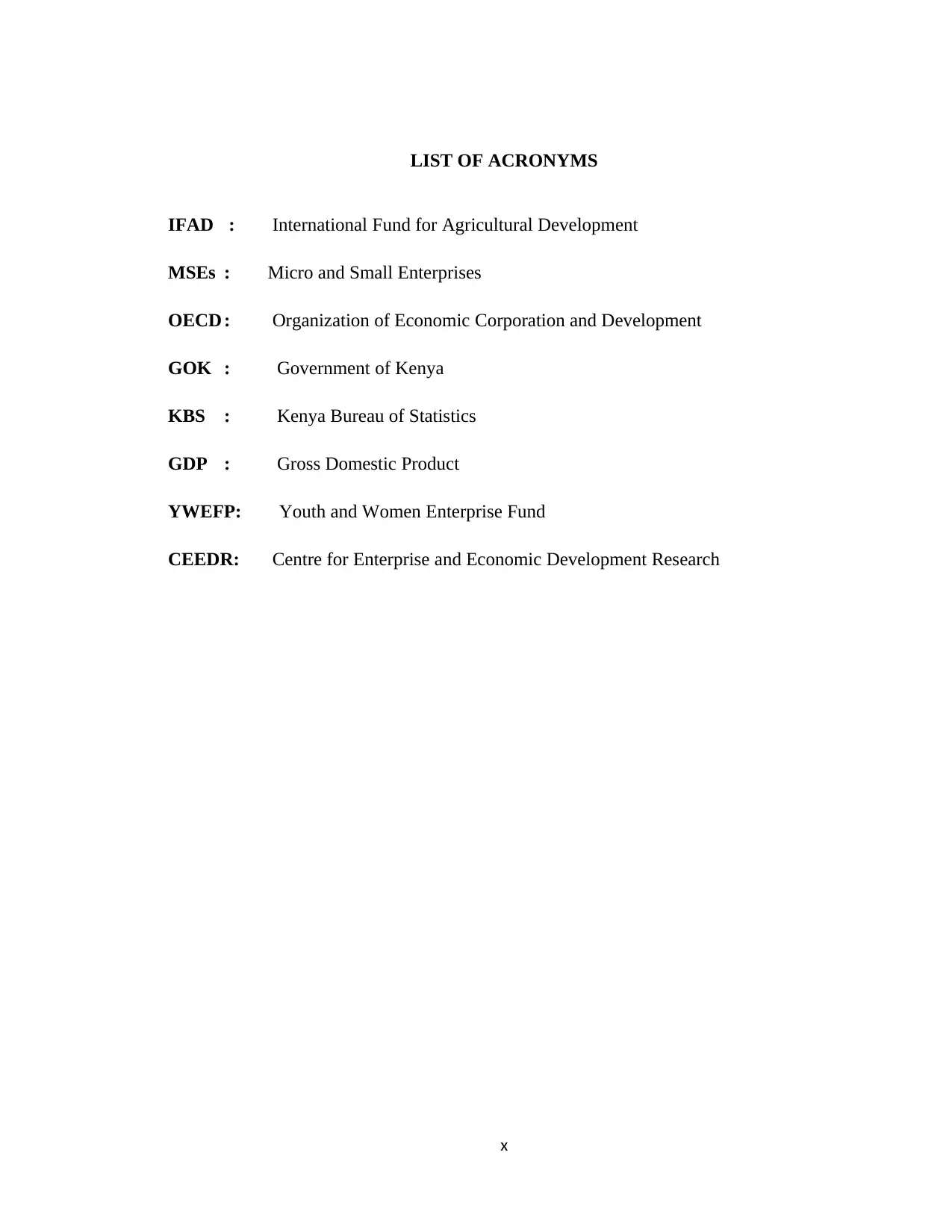
LIST OF ACRONYMS
IFAD : International Fund for Agricultural Development
MSEs : Micro and Small Enterprises
OECD : Organization of Economic Corporation and Development
GOK : Government of Kenya
KBS : Kenya Bureau of Statistics
GDP : Gross Domestic Product
YWEFP: Youth and Women Enterprise Fund
CEEDR: Centre for Enterprise and Economic Development Research
x
IFAD : International Fund for Agricultural Development
MSEs : Micro and Small Enterprises
OECD : Organization of Economic Corporation and Development
GOK : Government of Kenya
KBS : Kenya Bureau of Statistics
GDP : Gross Domestic Product
YWEFP: Youth and Women Enterprise Fund
CEEDR: Centre for Enterprise and Economic Development Research
x
Paraphrase This Document
Need a fresh take? Get an instant paraphrase of this document with our AI Paraphraser
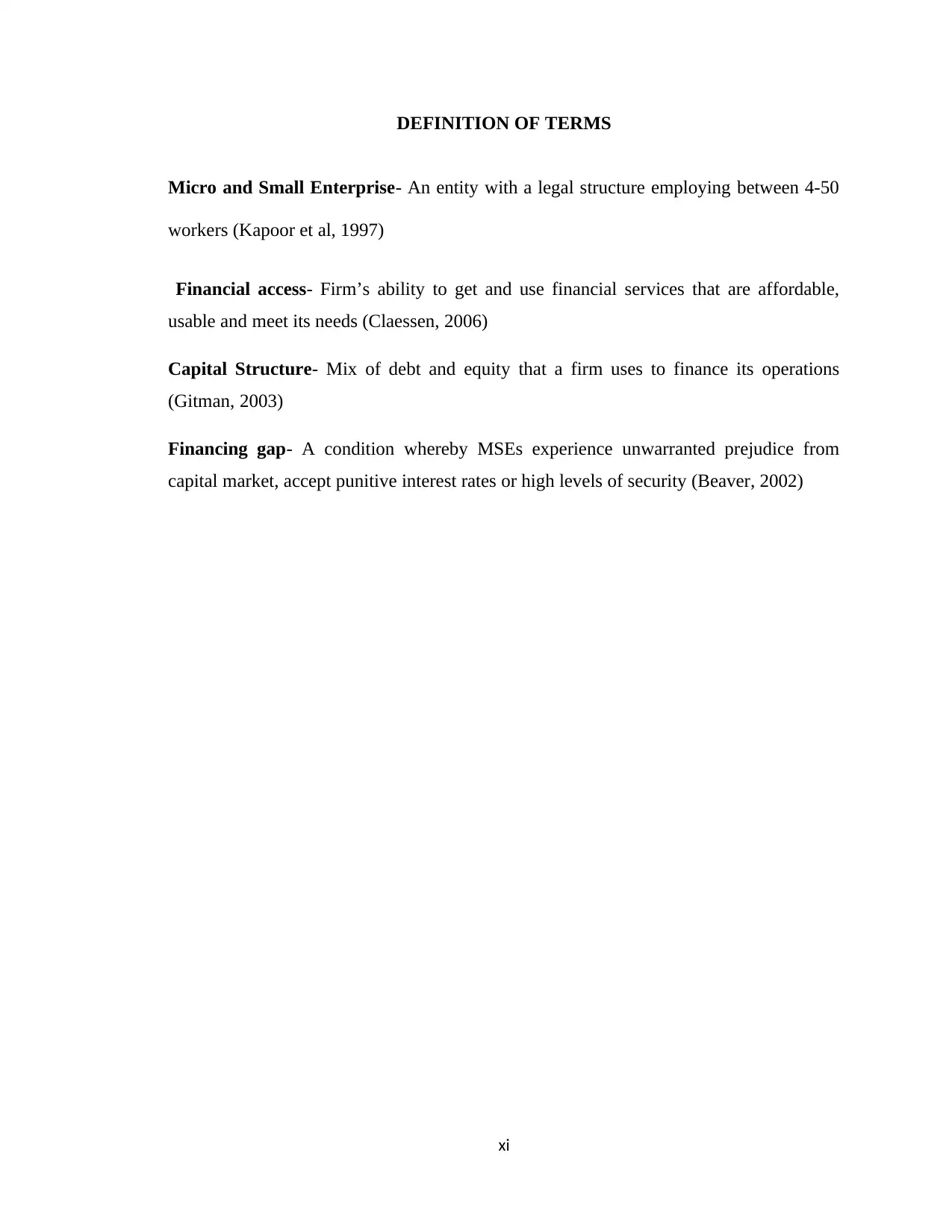
DEFINITION OF TERMS
Micro and Small Enterprise- An entity with a legal structure employing between 4-50
workers (Kapoor et al, 1997)
Financial access- Firm’s ability to get and use financial services that are affordable,
usable and meet its needs (Claessen, 2006)
Capital Structure- Mix of debt and equity that a firm uses to finance its operations
(Gitman, 2003)
Financing gap- A condition whereby MSEs experience unwarranted prejudice from
capital market, accept punitive interest rates or high levels of security (Beaver, 2002)
xi
Micro and Small Enterprise- An entity with a legal structure employing between 4-50
workers (Kapoor et al, 1997)
Financial access- Firm’s ability to get and use financial services that are affordable,
usable and meet its needs (Claessen, 2006)
Capital Structure- Mix of debt and equity that a firm uses to finance its operations
(Gitman, 2003)
Financing gap- A condition whereby MSEs experience unwarranted prejudice from
capital market, accept punitive interest rates or high levels of security (Beaver, 2002)
xi
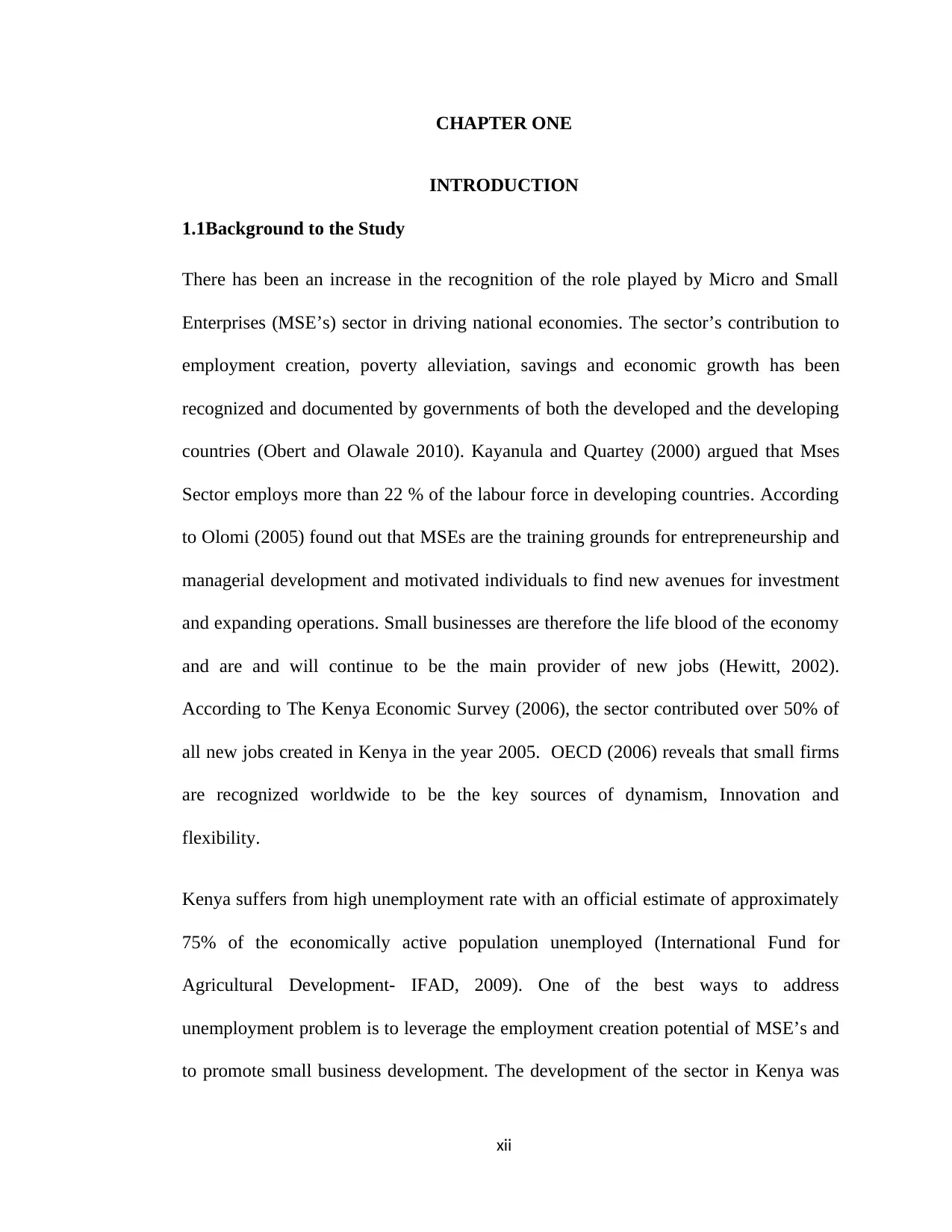
CHAPTER ONE
INTRODUCTION
1.1Background to the Study
There has been an increase in the recognition of the role played by Micro and Small
Enterprises (MSE’s) sector in driving national economies. The sector’s contribution to
employment creation, poverty alleviation, savings and economic growth has been
recognized and documented by governments of both the developed and the developing
countries (Obert and Olawale 2010). Kayanula and Quartey (2000) argued that Mses
Sector employs more than 22 % of the labour force in developing countries. According
to Olomi (2005) found out that MSEs are the training grounds for entrepreneurship and
managerial development and motivated individuals to find new avenues for investment
and expanding operations. Small businesses are therefore the life blood of the economy
and are and will continue to be the main provider of new jobs (Hewitt, 2002).
According to The Kenya Economic Survey (2006), the sector contributed over 50% of
all new jobs created in Kenya in the year 2005. OECD (2006) reveals that small firms
are recognized worldwide to be the key sources of dynamism, Innovation and
flexibility.
Kenya suffers from high unemployment rate with an official estimate of approximately
75% of the economically active population unemployed (International Fund for
Agricultural Development- IFAD, 2009). One of the best ways to address
unemployment problem is to leverage the employment creation potential of MSE’s and
to promote small business development. The development of the sector in Kenya was
xii
INTRODUCTION
1.1Background to the Study
There has been an increase in the recognition of the role played by Micro and Small
Enterprises (MSE’s) sector in driving national economies. The sector’s contribution to
employment creation, poverty alleviation, savings and economic growth has been
recognized and documented by governments of both the developed and the developing
countries (Obert and Olawale 2010). Kayanula and Quartey (2000) argued that Mses
Sector employs more than 22 % of the labour force in developing countries. According
to Olomi (2005) found out that MSEs are the training grounds for entrepreneurship and
managerial development and motivated individuals to find new avenues for investment
and expanding operations. Small businesses are therefore the life blood of the economy
and are and will continue to be the main provider of new jobs (Hewitt, 2002).
According to The Kenya Economic Survey (2006), the sector contributed over 50% of
all new jobs created in Kenya in the year 2005. OECD (2006) reveals that small firms
are recognized worldwide to be the key sources of dynamism, Innovation and
flexibility.
Kenya suffers from high unemployment rate with an official estimate of approximately
75% of the economically active population unemployed (International Fund for
Agricultural Development- IFAD, 2009). One of the best ways to address
unemployment problem is to leverage the employment creation potential of MSE’s and
to promote small business development. The development of the sector in Kenya was
xii
⊘ This is a preview!⊘
Do you want full access?
Subscribe today to unlock all pages.

Trusted by 1+ million students worldwide
1 out of 38